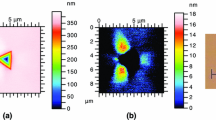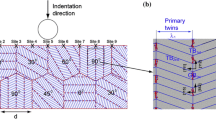Abstract
Indentation tips are never atomically sharp, but rounded at their end. We use atomistic simulation to study the effect of tip roundness for the particular case of a cube-corner pyramidal indenter by comparing the results of a spherical, a sharp cube-corner, and a rounded cube-corner tip during indention into bcc Fe. We find that as soon as the tip has indented so deeply that the spherical geometry does not hold any longer, strong deviations between the dislocation plasticity behavior show up. The rounded cube-corner tip produces less dislocations and a smaller plastic zone than the spherical indenter, when indented to the same depth. The results are better comparable, however, when the same displaced volume is considered. Finally, the dislocation nucleation mode is affected by the geometry, changing from homogeneous to heterogeneous nucleation as the tip changes from rounded to sharp. The cube-corner tips are found to produce more twinning and delay the formation of prismatic loops. For a penetration depth beyond the radius of the rounded cube-corner tip, atomic sharp pyramidal tips produce similar quantitative (hardness, dislocation density) and qualitative (pileup, dislocation arrangement) results compared to its rounded counterpart. Our results will prove important for understanding the differences between spherical indenter tips, as they are often used in simulation, and pyramidal tips, as they are used in experiment.







Similar content being viewed by others
References
Johnson, K.L.: Contact Mechanics. Cambridge University Press, Cambridge (1985)
Fischer-Cripps, A .C.: Nanoindentation, 2nd edn. Springer, New York (2004)
Armstrong, R.W., Elban, W.L., Walley, S.M.: Elastic, plastic, cracking aspects of the hardness of materials. Int. J. Mod. Phys. B 27, 1330004 (2013)
Armstrong, R.W., Walley, S.M., Elban, W.L.: Crystal indentation hardness. Crystals 7, 21 (2017)
Remington, T.P., Ruestes, C.J., Bringa, E.M., Remington, B.A., Lu, C.H., Kad, B., Meyers, M.A.: Plastic deformation in nanoindentation of tantalum: a new mechanism for prismatic loop formation. Acta Mater. 78, 378–393 (2014)
Ruestes, C.J., Stukowski, A., Tang, Y., Tramontina, D.R., Erhart, P., Remington, B.A., Urbassek, H.M., Meyers, M.A., Bringa, E.M.: Atomistic simulation of tantalum nanoindentation: effects of indenter diameter, penetration velocity, and interatomic potentials on defect mechanisms and evolution. Mater. Sci. Eng. A 613, 390–403 (2014)
Ruestes, C.J., Bringa, E.M., Gao, Y., Urbassek, H.M.: Molecular dynamics modeling of nanoindentation. In: Tiwari, A., Natarajan, S. (eds.) Applied Nanoindentation in Advanced Materials, Chapter 14, pp. 313–345. Wiley, Chichester (2017)
Ruestes, C .J., Alabd Alhafez, I., Urbassek, H .M.: Atomistic studies of nanoindentation—A review of recent advances. Crystals 7, 293 (2017b)
Van Vliet, K.J., Li, J., Zhu, T., Yip, S., Suresh, S.: Quantifying the early stages of plasticity through nanoscale experiments and simulations. Phys. Rev. B 67, 104105 (2003)
Ma, X.-L., Yang, W.: Molecular dynamics simulation on burst and arrest of stacking faults in nanocrystalline Cu under nanoindentation. Nanotechnology 14, 1208 (2003)
Zhu, T., Li, J., Van Vliet, K.J., Ogata, S., Yip, S., Suresh, S.: Predictive modeling of nanoindentation-induced homogeneous dislocation nucleation in copper. J. Mech. Phys. Sol. 52, 691 (2004)
Liang, H., Woo, C.H., Huang, H., Ngan, A.H.W., Yu, T.X.: Crystalline plasticity on copper (001), (110), and (111) surfaces during nanoindentation. Comput. Model. Eng. Sci. 6, 105 (2004)
Asenjo, A., Jaafar, M., Carrasco, E., Rojo, J.M.: Dislocation mechanisms in the first stage of plasticity of nanoindented Au (111) surfaces. Phys. Rev. B 73, 075431 (2006)
Tsuru, T., Shibutani, Y.: Anisotropic effects in elastic and incipient plastic deformation under (001), (110), and (111) nanoindentation of Al and Cu. Phys. Rev. B 75, 035415 (2007)
Ju, S.-P., Wang, C.-T., Chien, C.-H., Huang, J.C., Jian, S.-R.: The nanoindentation responses of nickel surfaces with different crystal orientations. Mol. Simul. 33, 905 (2007)
Carrasco, E., Rodríguez de la Fuente, O., Rojo, J.M.: Dislocation emission at the onset of plasticity during nanoindentation in gold. Philos. Mag. 88, 281 (2008)
Ziegenhain, G., Urbassek, H.M.: Effect of material stiffness on hardness: a computational study based on model potentials. Philos. Mag 89, 2225–2238 (2009)
Ziegenhain, G., Hartmaier, A., Urbassek, H.M.: Pair vs many-body potentials: influence on elastic and plastic behavior in nanoindentation of fcc metals. J. Mech. Phys. Sol. 57, 1514–1526 (2009)
Ziegenhain, G., Urbassek, H.M., Hartmaier, A.: Influence of crystal anisotropy on elastic deformation and onset of plasticity in nanoindentation: a simulational study. J. Appl. Phys. 107, 061807 (2010)
Paul, W., Oliver, D., Miyahara, Y., Grütter, P.H.: Minimum threshold for incipient plasticity in the atomic-scale nanoindentation of Au(111). Phys. Rev. Lett. 110, 135506 (2013)
Gao, Y., Ruestes, C.J., Tramontina, D.R., Urbassek, H.M.: Comparative simulation study of the structure of the plastic zone produced by nanoindentation. J. Mech. Phys. Sol. 75, 58–75 (2015)
Hagelaar, J.H.A., Bitzek, E., Flipse, C.F.J., Gumbsch, P.: Atomistic simulations of the formation and destruction of nanoindentation contacts in tungsten. Phys. Rev. B 73, 045425 (2006)
Biener, M.M., Biener, J., Hodge, A.M., Hamza, A.V.: Dislocation nucleation in bcc Ta single crystals studied by nanoindentation. Phys. Rev. B 76, 165422 (2007)
Alcalá, J., Dalmau, R., Franke, O., Biener, M., Biener, J., Hodge, A.: Planar defect nucleation and annihilation mechanisms in nanocontact plasticity of metal surfaces. Phys. Rev. Lett. 109, 075502 (2012)
Christopher, D., Smith, R., Richter, A.: Atomistic modelling of nanoindentation in Fe and Ag. Nanotechnology 12, 372 (2001)
Smith, R., Christopher, D., Kenny, S.D., Richter, A., Wolf, B.: Defect generation and pileup of atoms during nanoindentation of Fe single crystals. Phys. Rev. B 67, 245405 (2003)
Lu, C., Gao, Y., Michal, G., Deng, G., Huynh, N.N., Zhu, H., Liu, X., Tieu, A.K.: Experiment and molecular dynamics simulation of nanoindentation of body centered cubic iron. J. Nanosci. Nanotechnol. 9, 7307 (2009a)
Lu, C., Gao, Y., Michal, G., Huynh, N.N., Zhu, H.T., Tieu, A.K.: Atomistic simulation of nanoindentation of iron with different indenter shapes. Proc. IME J. 223, 977 (2009b)
Kumar, N.N., Tewari, R., Durgaprasad, P.V., Dutta, B.K., Dey, G.K.: Active slip systems in bcc iron during nanoindentation: a molecular dynamics study. Comput. Mater. Sci. 77, 260 (2013)
Gao, Y., Ruestes, C.J., Urbassek, H.M.: Nanoindentation and nanoscratching of iron: atomistic simulation of dislocation generation and reactions. Comput. Mater. Sci. 90, 232–240 (2014)
Alabd Alhafez, I., Ruestes, C.J., Bringa, E.M., Urbassek, H.M.: Influence of pre-existing plasticity on nanoindentation—An atomistic analysis of the dislocation fields produced. J. Mech. Phys. Solids 132, 103674 (2019a)
Verkhovtsev, A.V., Yakubovich, A.V., Sushko, G.B., Hanauske, M., Solov’yov, A.V.: Molecular dynamics simulations of the nanoindentation process of titanium crystal. Comput. Mater. Sci. 76, 20–26 (2013)
Alabd Alhafez, I., Ruestes, C .J., Gao, Y., Urbassek, H .M.: Nanoindentation of hcp metals: a comparative simulation study of the evolution of dislocation networks. Nanotechnology 27, 045706 (2016)
Avila, K.E., Küchemann, S., Alabd Alhafez, I., Urbassek, H.M.: Shear-transformation-zone activation during loading and unloading in nanoindentation of metallic glasses. Materials 12, 1477 (2019)
Alabd Alhafez, I., Ruestes, C.J., Bringa, E.M., Urbassek, H.M.: Nanoindentation into a high-entropy alloy—An atomistic study. J. Alloys Compd. 803, 618–624 (2019b)
Kelchner, C.L., Plimpton, S.J., Hamilton, J.C.: Dislocation nucleation and defect structure during surface indentation. Phys. Rev. B 58, 11085–11088 (1998)
Landman, U., Luedtke, W.D., Burnham, N.A., Colton, R.J.: Atomistic mechanisms and dynamics of adhesion, nanoindentation, and fracture. Science 248, 454 (1990)
Luan, B., Robbins, M.O.: The breakdown of continuum models for mechanical contacts. Nature 435, 929 (2005)
Wagner, R.J., Ma, L., Tavazza, F., Levine, L.E.: Dislocation nucleation during nanoindentation of aluminum. J. Appl. Phys. 104, 114311 (2008). https://doi.org/10.1063/1.3021305
Alabd Alhafez, I., Brodyanski, A., Kopnarski, M., Urbassek, H .M.: Influence of tip geometry on nanoscratching. Tribol. Lett. 65, 26 (2017)
Komanduri, R., Chandrasekaran, N., Raff, L.M.: Md simulation of atomic-scale friction. Phys. Rev. B 61, 14007 (2000)
Kenny, S.D., Mulliah, D., Sanz-Navarro, C.F., Smith, R.: Molecular dynamics simulations of nanoindentation and nanotribology. Philos. Trans. R. Soc. A 363, 1949–1959 (2005)
Jun, S., Lee, Y., Kim, S.Y., Im, S.: Large-scale molecular dynamics simulations of Al(111) nanoscratching. Nanotechnology 15, 1169–1174 (2004)
Yaghoobi, M., Voyiadjis, G.Z.: Effect of boundary conditions on the MD simulation of nanoindentation. Comput. Mater. Sci. 95, 626–636 (2014)
Mendelev, M.I., Han, S., Srolovitz, D.J., Ackland, G.J., Sun, D.Y., Asta, M.: Development of new interatomic potentials appropriate for crystalline and liquid iron. Philos. Mag. 83, 3977–3994 (2003)
Banerjee, S., Naha, S., Puri, I.K.: Molecular simulation of the carbon nanotube growth mode during catalytic synthesis. Appl. Phys. Lett. 92, 233121 (2008)
Allen, M. P., Tildesley, D. J. (eds.): Computer Simulation of Liquids ( Clarendon, Oxford, 1987)
Plimpton, S.: Fast parallel algorithms for short-range molecular dynamics. J. Comput. Phys. 117, 1–19 (1995)
Stukowski, A.: Visualization and analysis of atomistic simulation data with OVITO–The Open Visualization Tool. Model. Simul. Mater. Sci. Eng. 18, 015012 (2010)
Stukowski, A., Albe, K.: Extracting dislocations and non-dislocation crystal defects from atomistic simulation data. Model. Simul. Mater. Sci. Eng. 18, 085001 (2010)
Stukowski, A., Bulatov, V.V., Arsenlis, A.: Automated identification and indexing of dislocations in crystal interfaces. Model. Simul. Mater. Sci. Eng. 20, 085007 (2012)
Stukowski, A.: Structure identification methods for atomistic simulations of crystalline materials. Model. Simul. Mater. Sci. Eng. 20, 045021 (2012)
Stukowski, A., Arsenlis, A.: On the elastic-plastic decomposition of crystal deformation at the atomic scale. Model. Simul. Mater. Sci. Eng. 20, 035012 (2012)
Gerberich, W.W., Nelson, J., Lilleodden, E., Anderson, P., Wyrobek, J.: Indentation induced dislocation nucleation: the initial yield point. Acta Mater. 44, 3585–3598 (1996)
Li, J., Van Vliet, K.J., Zhu, T., Yip, S., Suresh, S.: Atomistic mechanisms governing elastic limit and incipient plasticity in crystals. Nature 418, 307–310 (2002)
Gunkelmann, N., Bringa, E.M., Kang, K., Ackland, G.J., Ruestes, C.J., Urbassek, H.M.: Polycrystalline iron under compression: plasticity and phase transitions. Phys. Rev. B 86, 144111 (2012)
Yao, W.Z., Krill III, C.E., Albinski, B., Schneider, H.-C., You, J.H.: Plastic material parameters and plastic anisotropy of tungsten single crystal: a spherical micro-indentation study. J. Mater. Sci. 49, 3705 (2014)
Terentyev, D.A., Osetsky, Y.N., Bacon, D.J.: Effects of temperature on structure and mobility of the \(<\)1 0 0\(>\) edge dislocation in body-centred cubic iron. Acta Mater. 58, 2477 (2010)
Kelly, A., Knowles, K .M.: Crystallography and Crystal Defects, 2nd edn. Wiley, Chichester (2012)
Alabd Alhafez, I., Urbassek, H .M.: Influence of tip adhesion on nanoindentation and scratching. Model. Simul. Mater. Sci. Eng 27, 065014 (2019)
Gao, Y., Lu, C., Huynh, N.N., Michal, G., Zhu, H.T., Tieu, A.K.: Molecular dynamics simulation of effect of indenter shape on nanoscratch of Ni. Wear 267, 1998 (2009)
Zhu, P.-Z., Hu, Y.-Z., Wang, H., Ma, T.-B.: Study of effect of indenter shape in nanometric scratching process using molecular dynamics. Mater. Sci. Eng. A 528, 4522 (2011)
Ma, L., Morris, D.J., Jennerjohn, S.L., Bahr, D.F., Levine, L.E.: The role of probe shape on the initiation of metal plasticity in nanoindentation. Acta Mater. 60, 4729–4739 (2012)
Goel, S., Cross, G., Stukowski, A., Gamsjäger, E., Beake, B., Agrawal, A.: Designing nanoindentation simulation studies by appropriate indenter choices: case study on single crystal tungsten. Comput. Mater. Sci. 152, 196–210 (2018)
Oliver, D., Paul, W., El Ouali, M., Hagedorn, T., Miyahara, Y., Qi, Y., Grütter, P.: One-to-one spatially matched experiment and atomistic simulations of nanometre-scale indentation. Nanotechnology 25, 025701 (2013)
Vishnubhotla, S.B., Chen, R., Khanal, S.R., Hu, X., Martini, A., Jacobs, T.D.B.: Matching atomistic simulations and in situ experiments to investigate the mechanics of nanoscale contact. Tribol. Lett. 67, 97 (2019)
Acknowledgements
HMU acknowledges support by the Deutsche Forschungsgemeinschaft (DFG, German Research Foundation)—Project Number 172116086—SFB 926. CJR and MCZ acknowledge support by ANPCyT PICT-2015-0342, SiiP-UNCuyo-2019-M088, a donation by the Nvidia Corporation, and computational resources at TOKO-FCEN-UNCuyo cluster. EMB thanks funding from SIIP-UNCuyo-2019-2021 grant. The work by MCZ was supported by an EVC scholarship from Consejo Interuniversitario Nacional - Argentina.
Author information
Authors and Affiliations
Corresponding author
Additional information
Publisher's Note
Springer Nature remains neutral with regard to jurisdictional claims in published maps and institutional affiliations.
Electronic supplementary material
Below is the link to the electronic supplementary material.
Electronic supplementary material 1 (AVI 1560 kb)
Rights and permissions
About this article
Cite this article
Zonana, M.C., Ruestes, C.J., Bringa, E.M. et al. Effect of Tip Roundness on the Nanoindentation of Fe Crystals. Tribol Lett 68, 56 (2020). https://doi.org/10.1007/s11249-020-01295-9
Received:
Accepted:
Published:
DOI: https://doi.org/10.1007/s11249-020-01295-9




